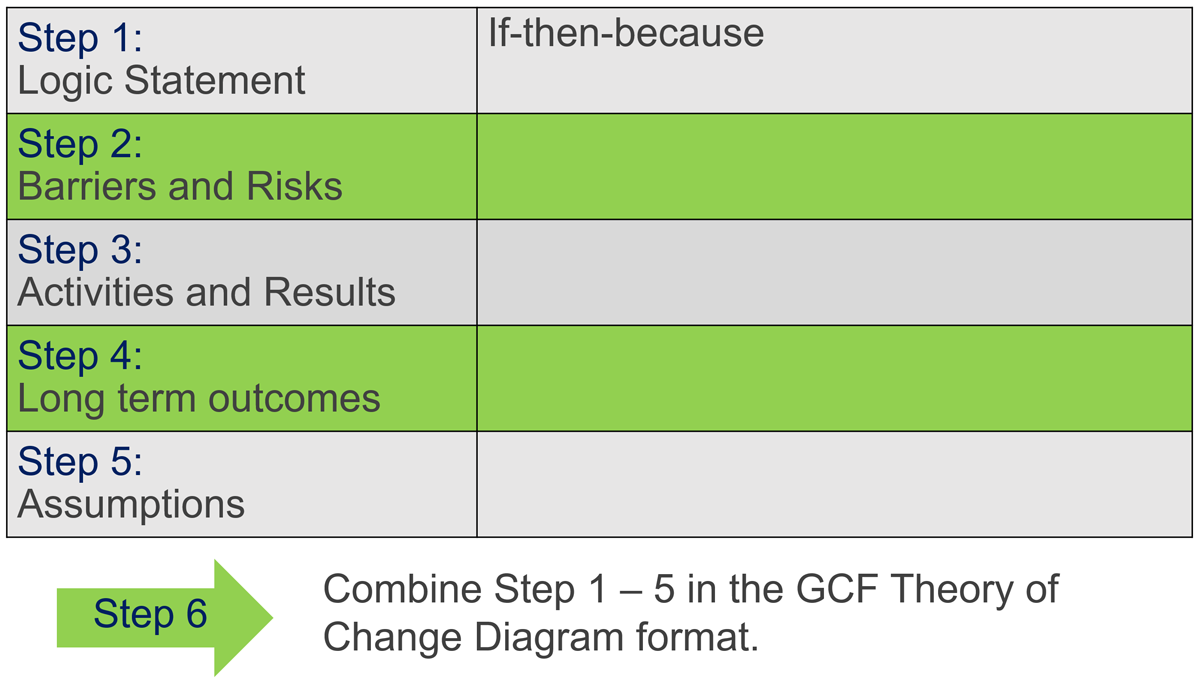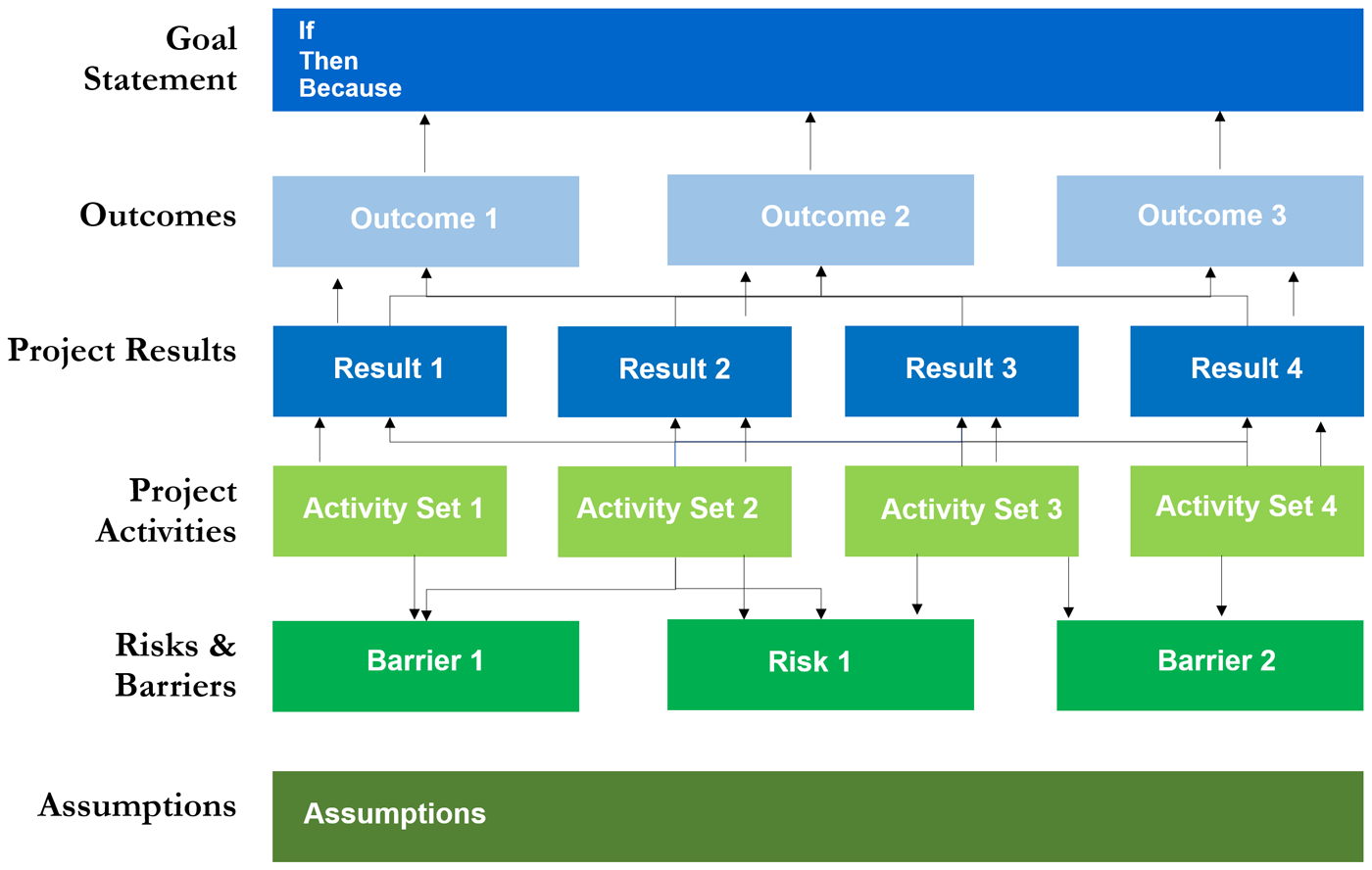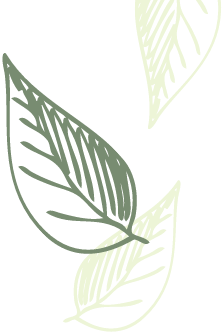The Theory of Change, also known as ToC, is a vital element in the development of a GCF Concept Note, serving as the strategic foundation for how a proposed project or programme is expected to deliver its intended climate impact, particularly low-emission and climate-resilient development. It provides a clear, logical, evidence-based pathway from inputs and activities to outputs, outcomes, and long-term impacts, ensuring the project is designed with strategic clarity and purpose. A well-crafted ToC helps align the proposal with GCF’s investment criteria, such as climate impact potential, paradigm shift, sustainable development, and country ownership. It also demonstrates how the project contributes to national climate strategies like Nationally Determined Contributions (NDCs) or National Adaptation Plans (NAPs), strengthening its relevance and coherence within the broader climate policy context. ToC also presents how the project links ground realities with GCF Sectoral Guides1 and GCF Strategic Plan 2024 – 20272, which has been prioritized in the new GCF Concept Note format.
Moreover, the ToC plays a key role in identifying critical assumptions and risks along the results chain, supporting a more robust risk assessment and the design of effective mitigation strategies. It forms the basis for monitoring and evaluation by outlining measurable indicators, which are essential for tracking progress and demonstrating results in line with GCF’s results-based financing approach. Additionally, the ToC enhances the overall credibility of the concept note by showing a deep understanding of the problem context, stakeholder dynamics, and system-level changes the project aims to influence. It also serves as a tool for inclusive project design, facilitating stakeholder engagement and ensuring their perspectives are reflected in the intervention logic. Overall, the Theory of Change is not just a planning framework, but a strategic requirement that significantly improves the quality, coherence, and fundability of a GCF Concept Note. In practice, the Theory of Change in a GCF Concept Note typically includes:
Theory of Change Development
Developing Theory of Change from Logical Framework
Evolving from a logical framework (logframe) to a Theory of Change (ToC) in the context of GCF Concept Note development involves a shift from a linear, output-focused planning tool (static result matrix) to a dynamic, systems-oriented approach that captures the complexity of climate change interventions (comprehensive roadmap of climate change). While both tools serve to clarify project objectives and results, the ToC offers a more flexible and comprehensive narrative and visual representation of how change will happen and why.
The table below can guide project developers in adapting traditional planning tools like the logframe into a more strategic, dynamic, and climate focused ToC required by GCF.
| Aspect | Logical Framework (Logframe) |
Theory of Change (ToC) |
How to Evolve for GCF Concept Note |
|---|---|---|---|
| Structure | Linear and fixed (inputs → activities → outputs → outcomes → impact) | Non-linear and flexible, includes feedback loops and multiple pathways | Expand beyond linear logic to capture complex, systemic change pathways |
| Focus | Deliverables and outputs | Change processes and causal pathways | Shift focus from what will be done to how and why change will happen |
| Assumptions | Often implicit or limited to a separate column | Explicit and central to the model | Clearly identify key assumptions and external factors at each stage |
| Stakeholder Involvement | Usually developed internally by project designers | Developed collaboratively with stakeholders | Involve national partners, communities, and beneficiaries to align with GCF's country ownership principle |
| Narrative | Minimal or absent; focuses on indicators | Includes a detailed change narrative | Add a descriptive explanation of how change is expected to occur and the rationale behind it |
| Results Orientation | Focus on outputs and immediate outcomes | Emphasizes long-term outcomes and impacts | Align outcomes with GCF's climate results areas and strategic objectives |
| Systemic Change | Rarely addressed | Central to the design (e.g., paradigm shift, scalability) | Highlight transformational potential, scalability, and policy/institutional influence |
| Use of Diagrams | Not always included or limited to logframe table | Visual representation is a key component | Develop a visual ToC diagram to communicate the logic of the project |
| Risk Management | Basic risk identification | Integrated with assumptions and context analysis | Build in risk and context analysis to demonstrate project robustness |
| Monitoring & Evaluation (M&E) | Based on fixed indicators tied to outputs/outcomes | Driven by outcomes, with indicators derived from the ToC | Use ToC to guide M&E strategy and link to GCF’s results framework |
Guide to Design a Theory of Change
A clear Theory of Change and risks and barriers to implementation is probably the most important element in a GCF Concept Note. It gives a clear explanation of the long-term vision for the project, with outputs and outcomes for the proposed activities. Identify risks and barriers to achieving the outputs and outcomes from the theory of change, which requires a detailed feasibility analysis and technical and economic analyses. At a glance, the theory of change of the proposed concept note can address all six GCF Investment Criteria.

The following Six Steps Guide can be conducted as an Exercise to design a Theory of Change
- Step 1Introduce the overarching logical framework (if we do “x”, then our desired “y” will happen, because “z”. Brainstorm on this until you are quite clear on the logic.
- Step 2Identify the barriers and risks that you would expect to overcome to achieve the desired outcomes
- Step 3Identify activities that would be carried out to overcome these barriers and risks. Also identify the results that would indicate the success condition in overcoming these barriers and risks and expected tangible results at the end of the project implementation period.
- Step 4Consider the longer-term outcomes of these results and the sustainability of the outcome. Consider whether these outcomes ensure that the project has the level of impact expected in your overarching logic statement.
- Step 5Identify the assumptions made in relation to any of the previous steps. Whether there are any of those assumptions so risky that they could be potential “project killers” and ensure that specific activities to validate these assumptions and provide sound evidence for the assumptions.
- Step 6Combine steps 1-5 in the GCF Theory of Change diagram format in Figure 5.5, abbreviating the text as needed. Note that additional details will be needed in the detailed concept note and full funding proposal.
Template
Problem Statement
The problem statement should describe the climate-related problem the project will address. Answering these questions could help in describing the problem statement:
- What are the climate vulnerabilities, emissions issues, or adaptation/resilience gaps?
- Who is affected and how?
- What barriers exist to solving the problem?
For example: “Smallholder farmers in Region X are increasingly exposed to drought due to climate change, reducing agricultural productivity and increasing food insecurity. A lack of access to climate-resilient infrastructure and knowledge exacerbates vulnerability.”
Long Term Goal/Impact
The desired long-term goal/impact should be defined and aligned with GCF’s result areas. Answering these questions could help in determining the long term goal/impact:
- What transformational change is expected?
- What long-term climate resilience or mitigation outcome is targeted?
For example: “Enhanced climate resilience and food security of vulnerable farming communities in Region X.”
Outcomes and Outputs
Map the causal pathway from activities → outputs → outcomes → impact. Consider the questions below to guide in mapping the causal pathway towards the outcomes and outputs.
(a).Outcomes (short, medium, long-term): What are the key behavioral or systemic changes that need to occur?
- Short-term: Improved capacity of local institutions.
- Medium-term: Adoption of climate-resilient agricultural practices.
- Long-term: Increased agricultural productivity and reduced vulnerability.
(b).Outputs: What are the tangible deliverables produced by the project?
- Training programs delivered to local extension officers.
- Climate-resilient seeds and inputs distributed.
- Irrigation infrastructure built.
Activities
List the core interventions required to achieve the outputs that are linked in the causal pathway made above.
For example:
- Conduct climate vulnerability assessments
- Train farmers and extension workers
- Rehabilitate/construct irrigation systems
- Provide climate information services
Assumptions and Precautions
To help with determining the causal pathway, identify key assumptions for each step in the pathway.
For example:
- Farmers will use training knowledge.
- Inputs are appropriate for local contexts.
- Political will and institutional support continue.
Risks and Mitigation Measures
To help with the assumptions and outputs, highlight potential risks to change and how they will be addressed.
For example:
| Risk: Resistance to adopting new practices | → | Mitigation: Use participatory approaches and local champions |
| Risk: Climate variability undermines infrastructure | → | Mitigation: Design using worst-case climate scenarios |
Link to GCF Results Area
To link the output with the GFC core result areas, it is important to map the desired outcomes and impact to GCF's core result areas.
For example:
- Mitigation – low-emission transport, energy efficiency
- Adaptation – Increased resilience of communities, ecosystems, and infrastructure
In addition, it is important to ensure that the project links ground realities with GCF Sectoral Guides3 and GCF Strategic Plan 2024 – 20274, which has been prioritized in the new GCF Concept Note format.
Summary of Theory of Change
Finally, summarize the ToC by explaining how and why your proposed activities will lead to the desired impact, referencing assumptions, stakeholders, and context.
For example:
“By providing smallholder farmers with access to climate-resilient inputs and training, and strengthening local agricultural extension services, the project aims to reduce vulnerability to drought. Combined with improved irrigation infrastructure and climate information systems, farmers will be better equipped to plan and adapt, leading to sustained productivity and food security.”
Visual Diagram
Having a visual diagram is optional but highly recommended to provide a visual representation of how the elements interact to construct the ToC. The Figure 5.6 illustrates the flowchart showing how the causality between Inputs/Activities, Outputs, Outcomes, Impact; how each elements providing feedback loops; and how the assumptions and external factors influencing the pathway.

- 1GCF. (2022). Sectoral Guides Summaries. Sectoral Guide Series. Yeonsu: Green Climate Fund.
- 2GCF. (2023). Strategic Plan for the Green Climate Fund 2024 – 2027. Decisions of the Board – thirty sixth meeting of the board, 10 – 13 July 2023. Yeonsu: Green Climate Fund.
- 3GCF. (2022). Sectoral Guides Summaries. Sectoral Guide Series. Yeonsu: Green Climate Fund.
- 4GCF. (2023). Strategic Plan for the Green Climate Fund 2024 – 2027. Decisions of the Board – thirty sixth meeting of the board, 10 – 13 July 2023. Yeonsu: Green Climate Fund.

